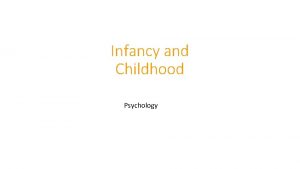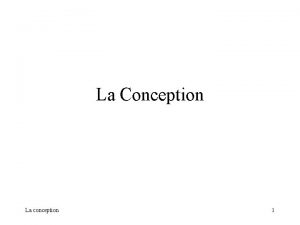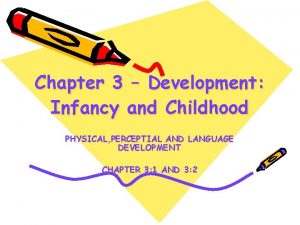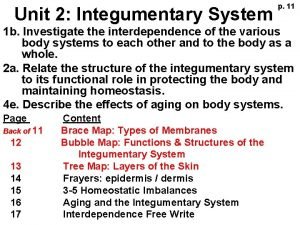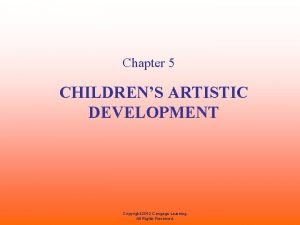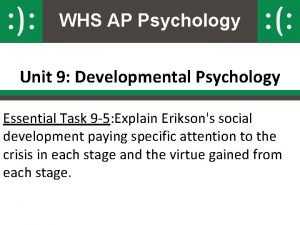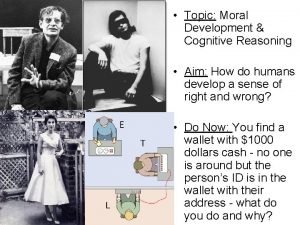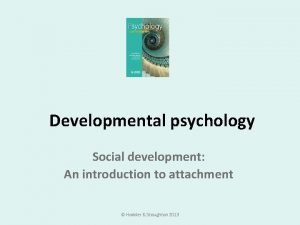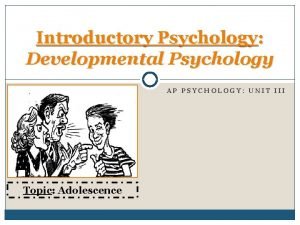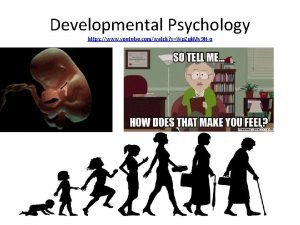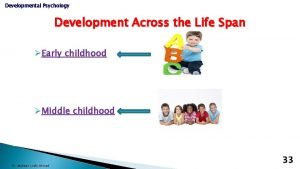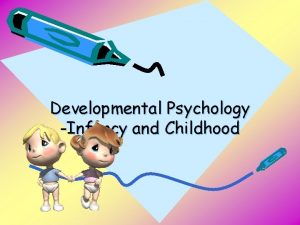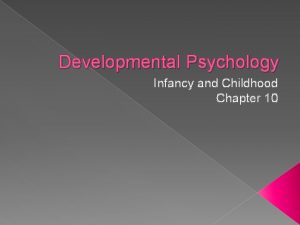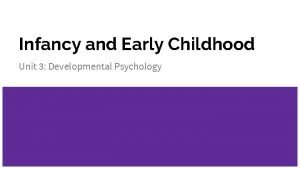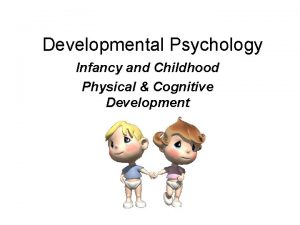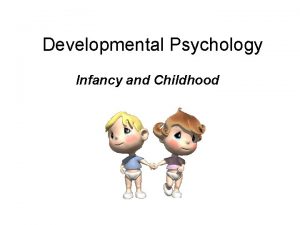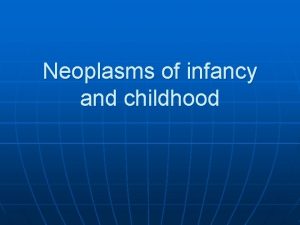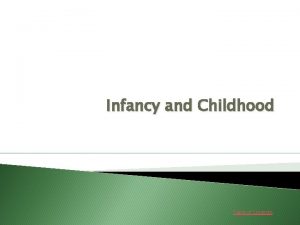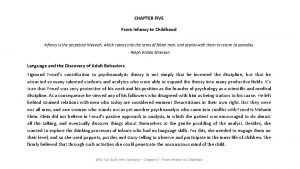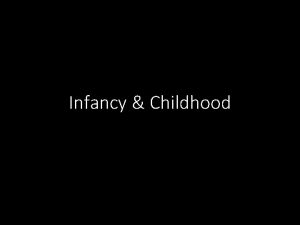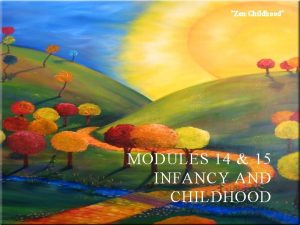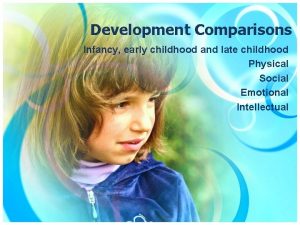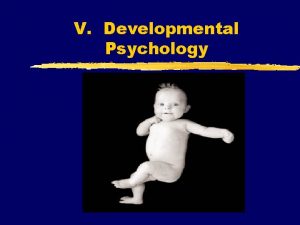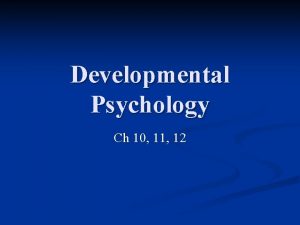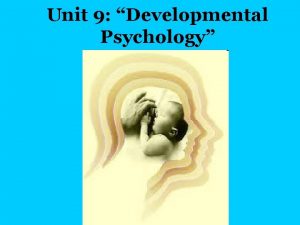DEVELOPMENTAL PSYCHOLOGY Conception Infancy and Childhood Agenda Grades
























- Slides: 24

DEVELOPMENTAL PSYCHOLOGY Conception, Infancy, and Childhood

Agenda Grades Activity Piaget and Social Development

The Conception Lottery The odds of your sperm meeting your egg 1 egg Only 200 about 1 out of 5000 get released. million sperm released The odds of you surviving the first two weeks: Less than half. Think about this the next time you feel unlucky.

Pregnancy Zygote Fertilized Egg Conception – Two Weeks Rapid cell division Embryo (Module 28) Attaches to uterine wall Outer cells become placenta; Inner cells become embryo Two weeks – 9 weeks Organs develop Fetus 9 weeks onward Organs can be formed enough to survive during 6 th month.

Environmental Effects In Utero Zygote Embryo Fetus Sounds Nutrition and Health Psychological State Increased Stress -> Increased Emotionability Teratogens Environmental agents that produce birth defects Drugs, Alcohol, Nicotine Viruses

Babies and Bacon The Blank Slate According to Bacon’s theory, what should babies be able to do at birth? Babies are more complicated than assumed For example: Nursing Technology

Early Reflexes Startle Rooting Grasping Sucking Aid survival

Newborn Senses Abilities and Preferences Smell Prefers mother Vision Prefers mother Acquired within days Hearing Aid in survival, security-seeking, creating social bonds Prefer novel stimuli and faces (especially the mother’s) Taste Sweet and Sour

Cognitive Development All neurons are essentially present at birth. 23 billion Neural Networks Memory Emphasis at birth: Walking Talking Memory (specifically automatic memory) Emphasis Frontal from 3 -6: Lobe

Organizing Information Schemas Assimilation Interpret new information based on schemas “Dog” Accommodation Change schemas based on new information “Dog” Children vs Adults Dogs, Cars, Schemas in Self and Groups

Theory of Cognitive Development Jean Piaget Children’s understanding of the world follows a predictable pattern Knowledge acquired Nature of understanding Stages of cognition Maturation through interaction with environment Build upon one another Order is universal, Timing varies Process is more continuous than stage-based

Sensorimotor Stage Birth – Two years Experience the world through senses and actions Neural Development Interest in new stimuli Object Permanence Peek-a-boo Marker Around 9 months

Sensorimotor Stage Underestimated infant thought Life lived, not thought about Notices inconsistencies, unusual actions Physics Doll, Car Visual Cliff

Preoperational Stage 2 -7 years Children begin representing their environment using words and images Language usage Begin using intuitive reasoning Principle of Conservation

Preoperational Stage Egocentrism Difficulty taking others’ perspectives Thinking and communicating from his/her point of view Telephone example “There are two boxes. Sue puts the ball in the left box and leaves the room. Sam takes the ball and puts it in the right box. Which box will Sue look in when she returns? ” Importance of language

Operational Stage 6 -12 years Children can think logically about concrete events Mastering arithmetical operations Reversibility 4+4=8, Analogies, Figures of Speech Enjoy 8 -4=4 wordplay jokes Lack of abstract thinking

Formal Operations 12 -Adulthood Characterized by abstract thought If x=y and y=z, what can you say about x and z? Pendulum Problem Thinking about hypothetical situations. Not everyone fully develops formal operations Even fewer use this thinking frequently

Socio-Affective Development Social Needs vs Biological Needs Harlow’s Monkeys Wire vs. Cloth Attachment Emotional bond between child and caretaker Most important attachments are formed during early childhood. Caretaker as a “base”

Attachment Styles Measuring Attachment Ainsworth’s Mother Strange Situation and toddler in a waiting room with toys Watch while together Watch while separated Watch when reunited Securely Attachment Avoidant Attachment Ambivalent Attachment

Attachment Effect of Attachment? Predicts Adult Attachment Hazan and Shaver Secure – Seek and desire close relationships Fearful Avoidant – Desires relationships, but fears bad outcomes Anxious-Ambivalent – Wants relationships but is uncomfortable being close to people. Dismissive Avoidant – Comfortable without many close relationships

Activity Brainstorm and Hypothesize Which attachment style will be most common here? Why? Which attachment style will be most common in the US? Why? Which attachment style will be least common here? Why? Which attachment style will be least common in the US? Why? Will there be a relationship between attachment style and happiness? If so, which style will be highest/lowest? Will there be a relationship between attachment style and self-esteem? If so, which style will be highest/lowest?

Frequencies KFUPM Secure Fearful-Avoidant US Students - 26 (42%) - 9 (15%) Anxious-Ambivalent - 13 (21%) Dismissive-Avoidant - 14 (23%) N=62 Secure - 12 (52%) Fearful-Avoidance - 1 (4%) Anxious-Ambivalent - 3 (13%) Dismissive-Avoidant - 7 (30%) N=23

Adult Attachment and Well. Being Happiness Self-Esteem Variable N Secure 4. 66 Fearful 4. 47 Ambivalent 14 Dismissive 13 Mean 26 Total 62 Mean 19 4. 44 4. 42 Variable N Secure 5. 57 Fearful 4. 85 Ambivalent 10 Dismissive 11 4. 53 Total 5. 42 9 48 8 5. 24 5. 71

Attachment and Culture influences relationship and parenting norms “Healthy” and “Normal” Attachment East Asia North Germany Predicting Well-Being Secure attachments -> Higher well-being Especially relationship happiness/satisfaction In U. S. Samples
 Principles of growth and development
Principles of growth and development Infancy and childhood psychology
Infancy and childhood psychology Psychology chapter 10 infancy and childhood
Psychology chapter 10 infancy and childhood Chapter 10 infancy and childhood review worksheet answers
Chapter 10 infancy and childhood review worksheet answers Psychology chapter 10 infancy and childhood
Psychology chapter 10 infancy and childhood Conception générale et détaillée
Conception générale et détaillée Social development in infancy and childhood
Social development in infancy and childhood Module 47 infancy and childhood cognitive development
Module 47 infancy and childhood cognitive development Internally programmed growth of a child
Internally programmed growth of a child Lesson quiz 3-2 infancy and childhood
Lesson quiz 3-2 infancy and childhood Rovee-collier
Rovee-collier Module 47 infancy and childhood cognitive development
Module 47 infancy and childhood cognitive development Infancy childhood adolescence adulthood old age
Infancy childhood adolescence adulthood old age Piaget’s stages of artistic development
Piaget’s stages of artistic development Ap psychology unit 9
Ap psychology unit 9 Lawrence kohlberg developmental psychology
Lawrence kohlberg developmental psychology Research methods in developmental psychology
Research methods in developmental psychology What is psychology
What is psychology John bowlby attachment theory
John bowlby attachment theory Developmental psychology
Developmental psychology Devonte is a graduate student in developmental psychology
Devonte is a graduate student in developmental psychology Authoritariam
Authoritariam Clp 3143 ucf
Clp 3143 ucf Sublimimation
Sublimimation Developmental psychology
Developmental psychology

